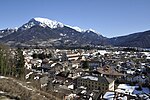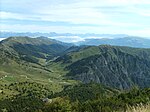Arsiè
Cities and towns in VenetoMunicipalities of the Province of BellunoVeneto geography stubs

Arsiè is a comune (municipality) in the province of Belluno in the Italian region of Veneto, located about 80 kilometres (50 mi) northwest of Venice and about 40 kilometres (25 mi) southwest of Belluno. As of 31 December 2004, it had a population of 2,748 and an area of 65.0 square kilometres (25.1 sq mi).The municipality of Arsiè contains the frazioni (subdivisions, mainly villages and hamlets) Mellame, Rocca, Fastro, Rivai, and San Vito. Arsiè borders the following municipalities: Castello Tesino, Cismon del Grappa, Enego, Fonzaso, Grigno, Lamon, Seren del Grappa and Pontet (a frazione of Imer, TN).
Excerpt from the Wikipedia article Arsiè (License: CC BY-SA 3.0, Authors, Images).Arsiè
Via Dante Alighieri,
Geographical coordinates (GPS) Address Nearby Places Show on map
Geographical coordinates (GPS)
| Latitude | Longitude |
|---|---|
| N 45.983333333333 ° | E 11.75 ° |
Address
Via Dante Alighieri
Via Dante Alighieri
Veneto, Italy
Open on Google Maps









